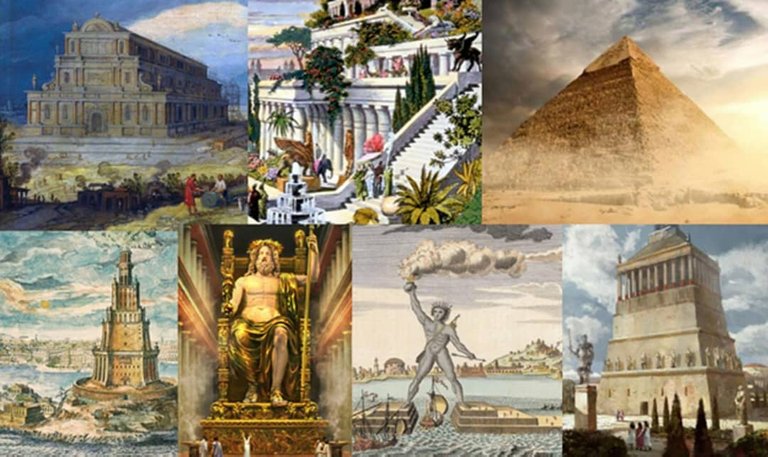
Fuente
Título: Manifestaciones del ingenio humano: las siete maravillas del mundo antiguo. (IV Parte. Final) Por Florencia Renata.
Aviso: pueden leer las anteriores entregas en los siguientes enlaces:

Fuente
Coloso de Rodas, Isla de Rodas, Grecia:
La enorme estatua fue construida en honor a Apolo, dios del sol para los antiguos griegos. Estaba ubicada en la entrada del puerto de la isla de Rodas, en el mar Mediterráneo. El escultor Cares de Lindos comenzó a construirlo hacia el año 290 a.C y la terminó unos doce años después.
Estaba fundida en bronce y tenía una altura de poco más de 30 metros. Según algunas referencias, descansaba sobre sus pies separados sobre moles que habían sido levantadas a cada lado de la entrada del puerto y tenía una antorcha siempre encendida en la mano derecha.
Lamentablemente, un terremoto que tuvo lugar alrededor de 225 a.C partió la estatua por las rodillas, precipitándola a tierra. El Coloso permaneció caído en el mismo lugar hasta el año 653 de la era actual, cuando unos invasores árabes lo hicieron pedazos para vender sus fragmentos como metal.

Fuente
Faro de Alejandría, la Isla de Faros, Grecia:
Hacia finales del siglo IV y principios del siglo III a.C, vivió en Alejandría un arquitecto de origen griego de nombre Sostrato de Gnido, quien se encontraba al servicio del faraón de Egipto, Tolomeo II. Por orden del faraón, Sostrato construyó en una península de la ciudad de Alejandría, un faro, que en su época se consideró como una hazaña técnica.
Sobre una amplia base cuadrada se levantó una torre octogonal de unos 100 metros de altura. Tenía tres niveles, todos inclinados un poco hacia adentro: el primero o inferior era cuadrado, el segundo o intermedio era octogonal y el superior donde se encontraba la almenara, era redondo, allí se construyó un recinto donde por las noches ardía un fuego alimentado con leña y resina.
Su función era ser señal y aviso para los navegantes. Este faro se mantuvo en pie hasta que un terremoto lo destruyó en el año 1375, y para el siglo XII, en el año 1477 sus piedras sirvieron para construir un fuerte.
Estos siete desarrollos creados por el ingenio humano, demuestran que no existen límites que le impidan avanzar a la humanidad. Estas hazañas o construcciones, que sin importar el tiempo que nos separe de ellos, siguen asombrando, maravillando, cautivando e inspirando generaciones tras generaciones, por igual, son un claro ejemplo de ello.

Fuente
Title: Manifestations of human ingenuity: the seven wonders of the ancient world. (Part IV. Final) By Florencia Renata.

Fuente
Colossus of Rhodes, Island of Rhodes, Greece:
The huge statue was built in honor of Apollo, god of the sun for the ancient Greeks. It was located at the entrance to the port of the island of Rhodes, in the Mediterranean Sea. The sculptor Cares of Lindos began to build it around the year 290 BC and finished it about twelve years later.
It was cast in bronze and had a height of just over 30 meters. According to some references, he rested on his feet apart on moles that had been raised on either side of the port entrance and had an always lit torch in his right hand.
Unfortunately, an earthquake that took place around 225 BC broke the statue at the knees, precipitating it to earth. The Colossus remained fallen in the same place until the year 653 of the current era, when some Arab invaders tore it to pieces to sell its fragments as metal.

[Fuente](https://www.pinterest.com/
Alexandria Lighthouse, the Island of Faros, Greece:
Towards the end of the IV century and the beginning of the III century BC, there lived in Alexandria an architect of Greek origin named Sostratus of Gnidus, who was at the service of the pharaoh of Egypt, Ptolemy II. By order of the pharaoh, Sostratus built on a peninsula of the city of Alexandria, a lighthouse, which in his time was considered as a technical feat.
On a wide square base an octagonal tower about 100 meters high was erected. It had three levels, all inclined a little inward: the first or lower one was square, the second or intermediate one was octagonal and the upper one, where the battleship was located, was round, an enclosure was built there where a fire fed with wood and resin burned at night.
Its function was to be a signal and warning for the navigators. This lighthouse remained standing until an earthquake destroyed it in the year 1375, and by the XII century, in the year 1477 its stones served to build a fort.
These seven developments created by human ingenuity demonstrate that there are no limits that prevent humanity from moving forward. These feats or constructions, which regardless of the time that separates us from them, continue to amaze, amaze, captivate and inspire generations after generations, alike, are a clear example of this.
It's interesting to hear about the Statue in Greece as I don't remember it being onevof the wonders I heard about as a kid.
People really had many achievements in the past, and I dislike how little history is respected nowadays!!
!hiqvote !PIZZA
@ahmadmanga, the HiQ Smart Bot has recognized your request (1/2) and will start the voting trail.
In addition, @flormarsal gets !WEED from @hiq.redaktion.
Discord. And don't forget to vote HiQs fucking Witness! 😻For further questions, check out https://hiq-hive.com or join our
I gifted $PIZZA slices here:
(1/15) @ahmadmanga tipped @flormarsal (x1)
Send $PIZZA tips in Discord via tip.cc!
Te felicito! Buen trabajo de investigación!